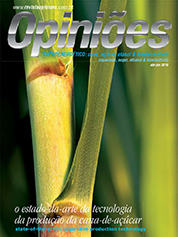Marcos Silveira Buckeridge
Scientific Director of CTBE
Op-AA-24
The achievement of cellulosic ethanol: a Brazilian innovation model
To produce ethanol from cellulose is easy. Take some paper strips, treat them with sulfuric acid and produce glycose. Next, neutralize the acid and add leaven to ferment. Then distil. Ready! Cellulosic ethanol was produced. No mystery at all. However, one sees the problems when one examines the process more closely. One is the cost at which one can produce ethanol from cellulose.
The biomass one wishes to produce in Brazil derives from sugarcane residues, which chemically are considerably more complex than the paper strips of our simple example above. Problems are also not only limited to the process’ technical issues; nor only to economic feasibility, but, above all, biomass must mainly be environmentally correct. We are looking for a truly sustainable product.
To come up with “integral” cellulosic ethanol several areas of society must interact and science is one of the most important and urgent of the areas. This is because the production of ethanol in Brazil has always focused on first generation ethanol. The sugarcane varieties de-veloped were conceived to produce saccharose. In light of the need to increase the world production of renewable energy, one has become alert to the fact that we are disposing of a large quantity of sugars that could be converted to ethanol.
Brazil’s position in this industry and scientific evolution in the past 20 years made the Brazilian innovation system reach a first world level in terms of science. This was possible due to investments made. Active participants were the government of the State of São Paulo, through FAPESP, and the Ministry of Science and Technology (MCT), through CNPq and CAPES. Government investment in the development of biotechnology for the production of ethanol already exceeds US$ 150 million. We are truly decided to take part in the global science match and no longer as bystanders. We are producing innovation.
Nowadays, there is an array of science and technology initiatives in progress in Brazil, which are organizing themselves in an unbelievable manner. FAPESP has officially created the BIOEN program, the MCT created CTBE - National Bioethanol Science and Technology Laboratory. The federal and state governments joined efforts with CNPq to launch “INCT do Bioetanol” (National Bioethanol Science and Technology Institute), co-financed by FAPESP, and recently the federal government launched “Sibratec of Bioethanol”, to finance industry-related projects.
Naturally, what was created is truly a Brazilian Innovation System for Bioethanol. The BIOEN and INCT projects focus on basic scientific output, handling fundamental issues that constitute bottlenecks in the cellulosic ethanol production process. Researchers seek to accelerate the production of new varieties and the complete sequencing of the sugarcane genome.
Plant physiologists and molecular biologists are getting together to under-stand how sugarcane plants react to dryness, how their fibers are formed, how cane is able to degrade its own cell membrane (where the sugars are that we want to extract). A group of specialists in microbiology is dedicated to prospecting fungi that produce enzymes, bringing about hydrolysis (degradation) of the cell membrane and produce leaven that causes fermentation in sugars with five carbon atoms, which is something that leaven we currently produce in first generation processes cannot do.
A group of specialists in protein and carbohydrates seeks to understand how mechanisms that determine interactions between hydrolases and their substrata – the polysaccharides - operate at the atomic and molecular levels. Thus, INCT and BIOEN may be considered major knowledge producers of the system, researching from the atomic to the atmospheric levels.
The other system that is being set up is that of CTBE. It is distinct in nature from INCT and BIOEN, given that CTBE’s focus is on the application of basic knowledge in industrial processes. The CTBE is being organized to constitute a group of scientists capable of combining the two systems to achieve optimal results from this combination.
The CTBE is implementing a Pilot Plant designed to function as a research lab, in which scientists can test hypotheses related to each step of the cellulosic ethanol production process (pre-treatment, hydrolysis, fermentation and distillation). This system, used in an integrated manner, may considerably accelerate reaching a high technology process at adequate cost.
The Brazilian Bioethanol Innovation System may turn out to be one of the most important Brazilian scientific achievements. This will render cellulosic ethanol feasible. After bagasse, the next will be straw. However, this is just the beginning, given that cane has an even higher potential because sugarcane compounds may become high aggregate value products for the food, drug, cosmetics, paper and other industries.
The Brazilian science and technology sector therefore has a golden opportunity to show that investment in know-ledge and innovation is worthwhile, because it results - in a sustainable manner - in foreign currency inflow, jobs and economic development. What is more important, is that Brazil is learning to promote innovation in an integrated manner, in what is a model that may, if investments continue, be applied in other areas, making the country stronger and prosperous.




